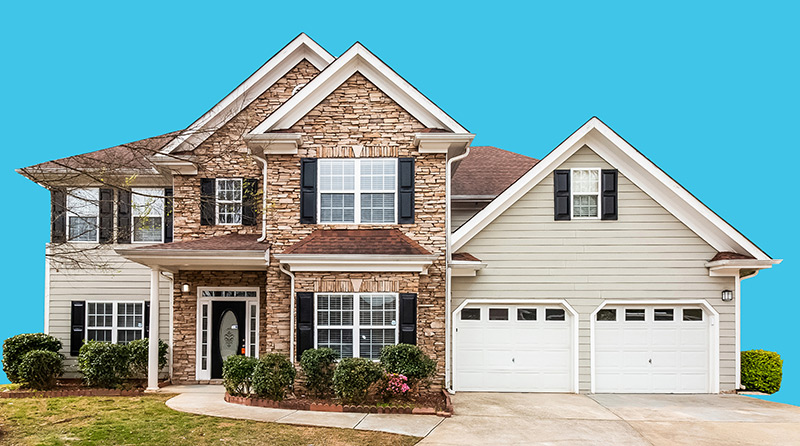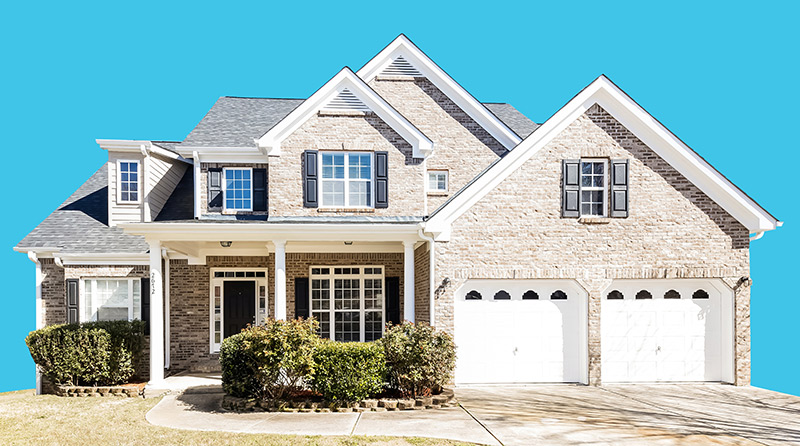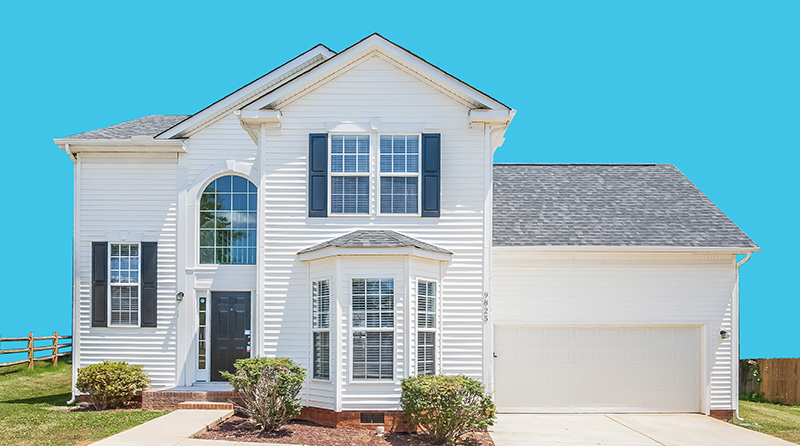房地产市场发生巨变,他利用人工智能从楼市赚钱
|
艾琳·伯罗斯近年来屡受挫折:被诊断出癌症后,她失去了房屋赎回权。现如今,她又恢复了健康,一份稳定的销售工作帮助她改善了财务状况。伯罗斯说:“我觉得一切都在好转。”生活稳定的一大标志是,她与丈夫和孩子们搬进了印第安纳波利斯中产阶级郊区格林伍德一栋拥有两间卧室的房子。这套房子是一家人租下的,而不是买下的。但是,对伯罗斯来说,重要的是不能让全家人住在公寓里。“我想让孩子们住在一个带有院落的房子,我很看重那种家庭氛围。”伯罗斯说。 伯罗斯的房东是一家名为Main Street Renewal的公司;她是从母亲那里知道这家公司的。她母亲在附近租了一套该公司名下的房子(母女俩合伙经营一家颇具人气的裁缝店)。她们所参与的,是一场雄心勃勃的实验。 Main Street Renewal隶属于阿默斯特控股公司(Amherst Holdings),后者是一家管理着200亿美元资产的房地产投资公司。它拥有或管理着约1.6万套分布在美国中西部和阳光地带的单户住宅。这一投资组合使得阿默斯特成为了机构房屋租赁市场上规模最大、增长最快的参与者之一。在大衰退之前,机构房屋租赁这样一个现在价值450亿美元的房地产行业分支几乎是不存在的。 阿默斯特的首席执行官肖恩·多布森是一位气宇轩昂的得克萨斯州数据专家。从大学退学后,他进入抵押贷款交易行业。十年前,他在房地产崩盘期间做空摇摇欲坠的债券,赚了一大笔钱。如今,在人工智能的帮助下,他每月为自己的商业帝国新增1000套住宅——利用数字建模,每天向可能会赚钱的住宅提供数十份报价。Main Street住宅是一项价值32亿美元的投资,每年可带来约3亿美元的租金收入,但多布森怀有更大的抱负:“我们希望在未来15年左右持有100万套住宅。”他说。尽管这一数字多少有点虚张声势(它是阿默斯特目前拥有房屋数量的60多倍),但它并不是无法想象的。这个事实表明,房地产市场已经发生巨变,而科技正在帮助投资者从这些变化中获利。 单户住宅租赁行业的兴起,反映了美国家庭财务状况和态度的深刻转变。长期以来,拥有住房一直是金融稳定的基石,但由于贷款标准收紧、大学债务负担过重、工资增长和储蓄增长滞后等原因,对于许多中等收入劳动者来说,拥有住房已经变得难以实现或不可取。研究公司Yardeni Research的数据显示,在金融危机前可能会购买第一套住房的家庭中,略高于三分之一的家庭现在要么租房,要么仍然与父母同住。 在这些趋势的推动下,目前有大约500万户家庭租住单户住宅,而不是贷款买房,而这正是阿默斯特的目标市场。它的专长是在体面的中产阶级郊区攫取破旧的房产——往往是在算法指导下进行的,这有助于避免竞价战和金钱陷阱——然后为新一代租房者精心装修这些房产。阿默斯特的典型客户是40岁出头的夫妇,有一两个孩子,家庭收入在6万美元左右。他们平均每月支付1450美元的房租。 “如果他们拥有这所房子,这几乎就是他们支付的抵押贷款和其他费用。”多布森说。“我们正在迎合一个全新的美国阶层——那些以前买房,现在要么被迫租房,要么自愿租房的美国人。”多布森笃信,这个新阶层将是永久性的。 |
Erin Burrus has endured some misfortune in recent years: After a cancer diagnosis, she lost her home to foreclosure. Today she’s healthy again, and a stable job in sales has helped her mend her finances. “I’m climbing my way back up,” says Burrus. One symbol of her stability is the two-bedroom home she shares with her husband and their children in Greenwood, a solidly middle-class suburb of Indianapolis. The family rents the place rather than owning their home. But it was important to Burrus that they not be in an apartment. “I wanted to get a house with a yard for the kids, for that family atmosphere,” she says. Burrus’s landlord is a company called Main Street Renewal; she found out about it from her mother, who rents a nearby home from the same outfit (and runs a thriving dress-alteration business with Burrus). And each is now playing a small part in an ambitious experiment. Main Street Renewal is an arm of Amherst Holdings, a real estate investing firm with $20 billion under management. It owns or manages some 16,000 single-family homes, scattered across the Midwest and the Sunbelt. That portfolio makes Amherst one of the biggest, fastest-growing players in institutionally owned rental homes, a $45 billion subsector of the real estate industry that barely existed before the Great Recession. Sean Dobson, Amherst’s CEO, is an imposing Texan data savant who dropped out of college to get into mortgage trading. A decade ago, he made a killing shorting shaky debt during the housing crash. Today he’s adding 1,000 homes a month to his empire with the help of artificial intelligence, using data modeling to make dozens of offers a day on potentially profitable houses. The Main Street homes are a $3.2 billion investment that generates around $300 million in annual rental income, but Dobson harbors far bigger ambitions: “We want to get to 1 million homes in the next 15 years or so,” he says. While that figure reflects as much bravado as realism—it’s more than 60 times the number of homes Amherst owns today—the fact that it’s conceivable shows how much the housing market has changed, and how technology is helping investors profit from those changes. The rise of the single-family-rental industry reflects profound shifts in the finances and attitudes of America’s families. Homeownership, long a bedrock of financial stability, has become unattainable or undesirable for many middle-income workers—for reasons including tighter lending standards, large college-debt loads, and lagging wage growth and savings. According to Yardeni Research, slightly more than one in three households that would have been buying first homes before the financial crisis is now either renting or still living with their parents. These trends translate into roughly 5 million households that are renting single-family homes rather than taking out mortgages and building equity, and that’s Amherst’s target market. Its specialty is grabbing run-down properties in nice, middle-class subdivisions—guided by algorithms that help it avoid bidding wars and money pits—which it then spruces up for the new rental generation. Amherst’s typical customers are couples in their early forties with one or two kids and household incomes around $60,000. They’re paying an average rent of $1,450 a month. “That’s almost exactly what they’d pay on a mortgage and other expenses if they owned the house,” says Dobson. “We’re catering to a whole new class of Americans—the former buyers who are now either forced renters or renters by choice.” And Dobson is betting that this new class is a permanent one. |
****
|
长期以来,单户住宅租赁一直由当地企业家主导,即夫妻投资者或拥有和管理不超过几十处房产(通常只有一处)的商界人士。从历史上看,当对冲基金和房地产投资信托基金(REITs)等大型机构投资租赁住房时,他们通常专注于公寓楼,因为这些庞大资产聚集在一起的密度使得它们管理起来更具成本效益。 2000年代的房地产崩盘改变了这一算术。随着经济拮据的家庭放弃购房,租房需求不断增加,投资者意识到,单户住宅可能是比公寓更稳定的收入来源。空置的公寓单元是一笔赔钱的买卖,而空置的单户住宅并不那么常见。房地产投资公司柯罗尼资本(Colony Capital)的负责人汤姆·巴拉克解释说,在单户住宅中,“一家人通常会住上两三年,而在公寓中只会住六个月到一年。”他补充说,需求一直居高不下,部分原因是那些过去将房屋视为投资的消费者不再相信房价会上涨。 这个行业仍然高度分散:机构投资者仅拥有美国1500万套单户租赁住房中的2%左右。但在过去的七年里,这些投资者已经积聚了一个庞大的投资组合——总共约30万套。最大的参与者包括Invitation home——这只房地产投资信托基金是黑石集团(Blackstone)、喜达屋资本(Starwood Capital)和柯罗尼资本等几家投资公司的租赁部门合并后的产物;American Homes 4 Rent;以及阿默斯特。所有这些房东都使用自动找房来推动业务增长。但阿默斯特与竞争对手的不同之处在于,它将电脑模式和商业模式的重点放在了美国住房市场的中间地带,即价格适中的郊区。 |
Single-family-home rentals have long been dominated by local entrepreneurs—mom-and-pop investors or groups of businesspeople who own and manage no more than a couple of dozen properties (and often as few as one). Historically, when bigger fish, such as hedge funds and real estate investment trusts (REITs), invested in rental housing, they focused on apartment buildings—larger assets whose bunched-together density made them more cost-effective to manage. The housing crash of the 2000s changed the math. As hard-pressed households gave up on ownership, and demand for rentals increased, investors realized single-family houses could be a more stable income source than apartments. An empty unit is a money loser, and houses were empty less often. Tom Barrack, head of real estate investment firm Colony Capital, explains that in single-family homes, “families stayed for two or three years, versus six months to a year in apartments.” Demand has stayed high, he adds, in part because consumers who used to see homes as investments are no longer confident that prices will rise. The business remains highly fragmented: Institutional investors own only about 2% of America’s 15 million single-family rental homes. But over the past seven years, those investors have amassed a substantial portfolio—some 300,000 houses in all. The biggest players include Invitation Homes, a REIT that’s the product of a merger of rental divisions of several investment firms, including Blackstone, Starwood Capital, and Colony Capital; American Homes 4 Rent; and Amherst. All these landlords use automated house-hunting to fuel their growth. But Amherst differs from its rivals in focusing its computer models—and its business model—on affordable suburbs in the solid middle of the U.S. housing sector. |



|
多布森的童年与这些郊区无缘。他是在一辆停泊在东得克萨斯州立公园的拖车里长大的,他家在那里拥有一个营地的特许经营权。“我爸妈租了几间小木屋来卖汽油。”多布森回忆道。“然后油价飙升,人们没有钱度假,这个乡下人的天堂就这样终结了。” 上高中的时候,全家搬到了休斯顿。父亲在消费电子零售商RadioShack给他买了一台TRS-80电脑。这个玩具改变了他的一生。多布森说,这台电脑产生了太多的静电,每当它运行时,家里的电视画面就会消失。但他由此成为一名专业程序员。在1987年高中毕业后的那个夏天,他在一家抵押贷款交易部门找到了一份IT工作。后来,他成为建立房屋贷款定价模型的先驱,并且善于利用这些模型发现投资者基于错误的风险预测对抵押贷款支持证券(MBSs)进行错误定价的实例。 1994年,多布森创立了阿默斯特的前身。到本世纪初,阿默斯特每年向养老基金和保险公司出售250亿美元的抵押贷款支持证券。他大获成功的种子是在房地产泡沫时期播下的,当时他的模型预测“Alt-A证券”(即向经常再融资的房主提供的一揽子贷款)会发生灾难。“市场预测违约率为5%,而我们的模型显示,即使房价不下跌,违约率也会达到30%。”多布森回忆道。他招募了一批投资者做空Alt-A,最终在房价下跌时斩获了高达100亿美元的利润——根据多布森本人的说法,这笔利润是投资额的10倍。 亲眼见证房地产市场崩溃的经历,让多布森意识到出租房屋的机会。到2011年,他启动了一场运动,寻求说服投资者为一个新的风险投资项目融资,即一只专注于以工业规模收购和出租单户住宅的基金。他的一些前合伙人看到了潜力。“单户住宅租赁基本上就是一场大型信息游戏,”马里纳投资集团(Mariner Investment Group)的负责人柯蒂斯·阿利奇表示。“如果你大规模购买的话,你会收集各种信息,而这些数据会带来一种竞争优势。” |
Dobson spent his childhood far from those burbs, in a trailer in an East Texas state park where his family owned a campground concession. “My mom and dad rented cabins and sold gas,” recalls Dobson. “Then oil prices spiked, people couldn’t afford vacations, and that was the end of the redneck paradise.” The family moved to Houston when Sean was starting high school, and his father bought him the toy that would change his life, a TRS-80 computer from Radio Shack. The device generated so much static, Dobson says, that the family’s TV picture dissolved when the computer was running. But he became an expert programmer, and the summer after his high school graduation in 1987, he got an IT job on a mortgage-trading desk. He became a pioneer in building sophisticated models to price home loans—and in using those models to find instances when investors were mispricing mortgage-backed securities (MBSs) based on faulty projections of their risks. In 1994, Dobson founded the forerunner to Amherst, and by the early 2000s, Amherst was selling $25 billion a year in MBSs to pension funds and insurers. The seeds of his big score were planted during the housing bubble, when his models predicted a disaster in “Alt-A securities,” packages of loans granted to homeowners who had often refinanced multiple times. “The market was predicting a default rate of 5%, and our models showed it would be 30% [even] if home prices didn’t fall at all,” Dobson recalls. He recruited a group of investors that took short positions in Alt-A, reaping a $10 billion profit—10 times the investment, according to Dobson—when home prices tumbled. Dobson’s front-row seat at the housing collapse helped him recognize the opportunity in rentals. By 2011 he had begun a campaign to persuade investors to finance a new venture—a fund to buy and rent out single-family homes on an industrial scale. Some of his former partners saw the potential. “Single-family rentals are basically a big information game,” says Curtis Arledge, head of Mariner Investment Group. “You collect all kinds of information if you buy at scale. That data gives him a competitive advantage.” |

|
大多数人对此持怀疑态度。为支撑他的想法,多布森此前已经在菲尼克斯和达拉斯购买了215套住宅。“这套投资组合并不理想。”他承认。“其中一些是布满涂鸦的内城住宅,还有一些住宅在郊区,离我们最近的房子有6英里远。我有没有提过至少有一所房子以前是妓院?”许多投资者认为,这个大杂烩组合集中体现了作为一位房东有可能遭遇的所有不幸——房产质量恶化,维持一个分布广泛的投资组合的麻烦,等等。“他们说我疯了,说这门生意不可能成功,会被‘千刀万剐’的。”多布森说。 经过一年的艰苦推销,多布森筹集了2亿美元。但这笔种子资金足以证明他的理念。他的首批房产所产生的利润,也足以说服投资者支持未来的几个融资轮。自从2011年以来,阿默斯特已经筹集了8只租赁住房基金,总额达50亿美元。在大多数情况下,它的合作对象都是一个大投资者——比如像TPG这样的私募股权巨头。投资者称,包括租金收入和价格上涨(当房价大幅上涨时,阿默斯特偶尔会出售一揽子住宅,其中一些有可能出售给其他投资者)在内,这些基金的平均年回报率在15%左右。由于该公司采用数字化手段逢低买进,这些回报要比通常情况下高得多。 |
Most were far more skeptical. To bolster his campaign, Dobson had purchased 215 houses in Phoenix and Dallas. “The portfolio wasn’t ideal,” he concedes. “We had graffiti-scarred houses in the inner city and houses in the suburbs six miles from the nearest house [we owned]. Did I mention that at least one dwelling was a former bordello?” Many investors saw the motley collection as epitomizing everything wrong with being a landlord—the deterioration of the properties, the hassles of maintaining a far-flung portfolio. “They said I was nuts, that this was an impossible business that would suffer ‘death by a thousand cuts,’ ” Dobson says. It took a year of hard selling for Dobson to raise $200 million. But that seed money was enough to prove his concept. His first properties yielded enough profit to persuade investors to finance future rounds. Since 2011, Amherst has raised eight rental-housing funds totaling $5 billion. In most cases, it has partnered with a single big investor—among them, private equity giants like TPG. The funds have produced average annual percentage returns in the mid-teens on their cash stakes, according to investors, including income from rent and price appreciation. (Amherst occasionally sells packages of homes when prices rise sharply, including to other investors.) And those returns are bigger than they would otherwise be, thanks to the firm’s digitally driven bargain hunting. |
****
|
在驱车穿过达拉斯郊区阿灵顿和德索托时,阿默斯特的董事总经理乔·内格里迅速地指出了一些需要修缮的房屋。大约五分之一的房子符合条件。内格里向我展示了一些典型的迹象:被单塞在窗户里,院子里的空调生锈了。他说,在房子里,我们很可能会发现瓷砖从混凝土地板上剥落下来。 找到像这样破旧的住所,并让它们变得体面,是阿默斯特经营策略的重中之重。阿默斯特依靠人在城镇和社区寻找一些有利可图的待修缮房屋,然后依靠自动化技术来挑选具体的投资对象。31岁的内格里是该团队负责人。他每年要花150天奔波在从亚特兰大到丹佛的道路上,潜心寻找所谓的“甜点社区”,即那些房屋租金适中,并且拥有强大的中等收入就业基础的社区。 在阿默斯特拥有的1.6万套住宅中,约70%位于阳光地带城市:亚特兰大和达拉斯加起来约占5300套;休斯顿、夏洛特和杰克逊维尔也是大市场。阿默斯特也青睐那些拥有坚实就业基础的铁锈地带“都市”,比如印第安纳波利斯、路易斯维尔和圣路易斯。这些市场都有一些力量在抑制住房成本。在阳光地带,新建筑扮演着这个角色;在铁锈地带,相对温和的经济和劳动力增长使得住房价格保持在较低水平。这两种情况都与洛杉矶和波士顿等沿海市场形成了鲜明对比。在这些沿海城市,由于缺乏新建筑,加之当地经济过热,房价不断上涨。潜心耕耘价格适中的市场,并专注于需要修缮的房屋,有助于阿默斯特将每套住宅的全部成本(包括维修在内)保持在非常低的水平——比如,孟菲斯和达拉斯的平均成本分别为14万美元和20.8万美元。(全美现房的价格中位数为26.73万美元。)它们的价格也几乎总是低于这些市场的平均水平。 内格里的工作是,确保低价格不是经济凋零的迹象。“首要标准是就业的多样性。”特别是蓝领和中产阶级工作。在阿默斯特选择进入一个新都市之前,内格里会亲自探访该市的社区。“我会连续住一个月的酒店,手持iPad到处转悠。”他说。“一大早开车探访圣路易斯郊区Florissant时,我发现,每两三个人中就有一位穿着波音公司的制服。这给了我很大的信心。”一个很可能导致交易搁浅的现象是:在上午10点左右,汽车仍然停在车道上,这表明许多居民没有工作,赚不到薪水。 基于像内格里这样的研究,阿默斯特现在将目标锁定在30个都市中的1000个邮编区。在那里选购房子,则是高度自动化的采购系统的工作。在该公司位于纽约麦迪逊大道19层的办公室里,十多名采购专家正在各自的工作台上筛选线索,后者由一个名为Explorer的专有程序提供。Explorer是多布森开发抵押贷款定价软件时的一个衍生物。每天早上,该团队都会收到一系列符合其价格范围和地理标准的新上市房屋信息——每天大约有1400套房源。 对于每栋新上市房屋,Explorer都会估算其翻新成本。这是机器学习技术大显身手的地方:这个估算所依靠的,是阿默斯特在相同或邻近社区翻新房龄和面积相仿的住宅的经验。在一栋老房子里,翻新工作可能包括更换暖通空调系统,而那些照片显示有磨损的房子,可能需要更换一个新屋顶。(团队成员帮助软件做出这样的决定。) 内格里声称,Explorer的估算相当精确,实际装修成本与估算的平均误差在5%以内。 Explorer还进行另一项计算。它会在新上市房源的两英里半径内寻找三套房龄、面积、卧室和浴室规格与其相近的出租房屋。机器学习帮助该软件根据这些“比较对象”来估计每套房屋的租金。然后,Explorer会生成一个“租金收益率”—— 扣除税费和维护等费用后的净租金,除以全部成本。 如果这个收益率达到阿默斯特的目标(据《财富》杂志估计在5%到6%之间),该团队将提供报价。每天约有20%的房源符合条件;在这些房子首次挂牌后不超过12个小时,阿默斯特就会提出全现金报价。约10%的报价(每天约30套)随后被卖家接受,进入签约环节。在宽限期内,阿默斯特会派遣检查员评估每栋住宅的情况。如果他们没有发现一些致命意外(比如地基开裂)的话,这些房屋会通过检验,加入Main Street Renewal的投资组合之列。 |
On a drive through Arlington and DeSoto, two Dallas suburbs, Amherst managing director Joe Negri is quick to point out the fixer-uppers. About one house in five qualifies. Negri shows me the classic signs: bedsheets stuffed in the windows, rusting AC units in the side yards. On the inside, he says, we are likely to find glued-down vinyl tiles peeling off the concrete floors. Finding shabby abodes like these and making them respectable is the load-bearing wall of Amherst’s strategy. Amherst depends on humans to find cities, towns, and neighborhoods where fixer-uppers can become profitable, then relies on automation to pick individual homes. Negri, 31, heads the human team. He spends 150 days a year on the road overseeing Main Street Renewal’s operations from Atlanta to Denver, searching for “sweet spot” neighborhoods that combine affordable rents with a strong middle-income employment base. Around 70% of Amherst’s 16,000 homes are in Sunbelt cities: Atlanta and Dallas, combined, account for about 5,300; Houston, Charlotte, and Jacksonville are also big markets. Amherst also favors Rust Belt “metros” with a sturdy foundation of jobs, including Indianapolis, Louisville, and St. Louis. These markets are all shaped by forces that keep housing costs in check. In Sunbelt cities, new construction plays that role; in the Rust Belt, relatively modest economic and workforce growth keep housing cheap. Each is an antithesis to coastal markets such as Los Angeles and Boston, where a dearth of new building and superheated local economies inflate prices. Focusing on fixer-uppers in modestly priced markets helps keep Amherst’s all-in costs for each home, including repairs, remarkably low, ranging from an average of $140,000 in Memphis to $208,000 in Dallas. (The median existing-home price nationwide is $267,300.) They’re almost always priced below the average in those markets too. Making sure low prices aren’t a sign of economic zombiehood is Negri’s job. “The No. 1 criteria is diversity of employment,” he says, especially in blue-collar and middle-class jobs. Before Amherst chooses a new metro, Negri explores its neighborhoods firsthand. “I’ll live in a hotel for a month straight, driving around with an iPad,” he says. “I was driving the Florissant area of St. Louis early in the morning, and one out of every two or three people are dressed in Boeing uniforms. That gave me a lot of confidence.” A dealbreaker: cars sitting in the driveway in mid-morning, a sign that a lot of residents aren’t getting paychecks. Based on research like Negri’s, Amherst now targets around 1,000 zip codes in 30 metro areas. Choosing homes there is the job of Amherst’s highly automated purchasing system. In its 19th-floor office on New York City’s Madison Avenue, a dozen buying specialists screen leads on their workstations, delivered by a proprietary program called Explorer, an offshoot of the software Dobson developed to price mortgages. Each morning, the team gets alerts on newly listed homes that meet its price range and geographic criteria—around 1,400 listings a day. For each “first cut” listing, Explorer estimates the costs of renovation. This is machine learning at work: The estimate is based on Amherst’s experience with homes of similar age and size in the same or nearby neighborhoods. In an older home, this might include replacing the HVAC system; for one whose listing photos suggest wear and tear, it might include a new roof. (Team members help the software make that call.) Explorer has become so precise, Negri says, that the actual renovation costs average within 5% of the estimates. Explorer also runs a separate calculation, finding three homes being rented within a two-mile radius that are close in age, size, and bed-and-bath specs to the newly listed home. Machine learning helps the software estimate what each house would rent for based on these “comps.” Explorer then churns out an estimated “rental yield”—the net rent after such expenses as taxes and maintenance, divided by all-in cost. If that yield meets Amherst’s target (which Fortune estimates is between 5% and 6%), the team will make an offer. About 20% of each day’s listings qualify; Amherst bids on those candidates no more than 12 hours after they’re first listed, making all-cash offers. Around 10% of its offers—on roughly 30 homes a day—get accepted and go to contract. Amherst dispatches inspectors to assess each home’s condition during the grace period. Unless they find fatal surprises—such as a cracked foundation—the houses pass muster and join the Main Street Renewal portfolio. |
****
|
当然,一旦你拥有一栋需要修缮的住宅,你就需要把它修好。阿默斯特在每套住宅上平均花费2.8万美元用于装修,在阿默斯特的客户群中,许多中产家庭都能攒下购买这类低价格房屋的首付款,但很少有人拥有大规模改造升级的财力。 在达拉斯和亚特兰大,我参观了十几栋Main Street Renewal房屋。这些房屋,尤其是内部结构,与新建筑的相似程度给我留下了深刻的印象。这些房子都有不同的平面布局,但在每一个不同的“盒子”里,阿默斯特安装了相同的功能——就是那种你在一栋崭新的中高端房屋中经常看到的固定装置和品牌。在亚特兰大郊区道格拉斯维尔一栋有6年历史、面积达3,100平方英尺的住宅内,阿默斯特安装了4台闪闪发光的通用电气(GE)新电器:炉子、洗碗机、冰箱和微波炉。台面是厚厚的石英;楼下的地板铺设着结实的瓷砖;Hampton Bay吊扇在客厅和主卧嗡嗡作响。租金为每月1,850美元。 在附近的奥斯特尔,一幢更小、更便宜,也更老的Main Street住宅——建于1997年、面积1,850平方英尺——正在进行内部装修。地毯被撕破了,脏兮兮的,厨房的天花板耷拉下来。但工人们正在安装与道格拉斯维尔那栋房屋相同的电器、地板和其他设施。它的最终花费达到道格拉斯维尔翻修工程的两倍。但这栋住宅将以1,695美元的价格出租,足以获得阿默斯特所追求的收益。 规模经济帮助这些翻修获得了回报。据阿默斯特估算,要想获得该公司花费2.8万美元的翻修效果,普通买家至少需要花费4.4万美元。由于阿默斯特的采购量如此之大,它能够以大幅打折的合同价格购买设备。例如,它为每户住宅购买4台通用电气电器时,总共花了1,850美元,而一位自己动手装修的普通买家差不多需要花费3,000美元,才能在家得宝(Home Depot)买到这些电器。装修是由外部承包商处理的,但许多承包商的大部分业务都是拜阿默斯特所赐,因此成本是可预测的,很少超支。 此外,阿默斯特的租户还得益于一项历史悠久的租赁特权:不用承担维修费用。大部分维修工作都是由该公司负责每个市场的员工完成的。在达拉斯及其郊区,28名维修工人驾驶着一支由10辆白色维修车组成的车队,每辆车都带有Main Street Renewal的标志,并且装有备用瓷砖、时髦的“蛾灰色”油漆和吊扇等设备。 |
Once you own a fixer-upper, of course, you need to fix ’er up. Amherst spends an average $28,000 per home, roughly 20% of the purchase price, on renovations. Many of the middle-class families in Amherst’s customer base could amass the down payment to buy the same low-priced homes, but few would have the savings to also fund big improvements. Touring a dozen Main Street Renewal houses in Dallas and Atlanta, I was impressed by how closely the homes, especially the interiors, resembled new construction. The houses all had different floor plans, but within each varied box, Amherst installed the same features: the kinds of fixtures and brands you’d find in a new middle-to-higher-end subdivision. In a six-year-old, 3,100-square-foot home in Douglasville, a suburb of Atlanta, Amherst had installed four gleaming new GE appliances: stove, dishwasher, fridge, and microwave. The countertops were thick quartz; the downstairs floors were sturdy ceramic tile; Hampton Bay ceiling fans whirred in the living room and master bedroom. The rent: $1,850 a month. In nearby Austell, a smaller, cheaper, and older Main Street home—1,850 square feet, built in 1997—was undergoing a gut renovation. The carpeting was ripped and stained, and the vinyl ceiling in the kitchen sagged. But workers were installing the same appliances, flooring, and other features as in the Douglasville house. The Austell renovations would eventually cost twice what the Douglasville ones did. But that house would rent for $1,695—enough to reap the yield Amherst seeks. Economies of scale help these renovations pay off. The improvements that cost Amherst $28,000 would, by the company’s estimates, cost a regular buyer at least $44,000. Because Amherst purchases in such high volumes, it can buy fixtures on heavily discounted national contracts. Its cost for the four GE appliances combined, for example, is $1,850 per home; a do-it-yourselfer would pay around $3,000 at Home Depot. The renovations are handled by outside contractors, but many rely on Amherst for most of their business, so costs are predictable and overruns are rare. Amherst’s tenants also benefit from a time-honored privilege of renting: not being on the hook for repairs. In-house crews in each market handle most of that. In Dallas and its suburbs, a crew of 28 maintenance workers pilots a fleet of 10 white repair vans, each bearing the Main Street Renewal logo and each stocked with spare tiles, trendy “moth gray” paint, and ceiling fans. |
****
|
阿默斯特已经找到了为快速增长的新租户群体提供服务的方法。多布森面临的问题是,这一群体是否会继续增长。 一些专家认为,购房者数量的下降是暂时的,更多的千禧一代和家庭即将步入买房阶段。美国企业研究所(American Enterprise Institute)的经济学家、抵押贷款巨头房利美(Fannie Mae)的前首席信贷官艾德·平托指出,这或许不会摧毁阿默斯特的商业模式,但有可能抑制投资者的热情。“华尔街玩的是热钱,没有耐心。”平托说。“他们将选择退出,或削减收购规模。” 多布森承认,需求激增可能会阻碍他的策略。如果“低价带”的房价飙升,阿默斯特的收购成本就会上升。此外,由于单户住宅的租金往往与房价挂钩,该公司的客户可能会选择租公寓,而不是租单户住宅。他说:“如果房价增速超过收入增速,我们就无法实现租金盈利,也无法扩大我们的投资组合。” 不过,多布森并没有看到这样的威胁,他认为大多数趋势都在朝着有利于他的方向发展。如果经济放缓,阿默斯特将从两方面受益:房价将下跌,从而为投资者创造购买机会,租金需求也将随之上升。他认为,无论经济如何发展,他的产业都会受益于规模的扩大。他相信,由于一大批老年房东的子女都没有兴趣修厕所,收房租,他们往往会选择把房子卖给大机构,可供阿默斯特收购的房屋将增加数百万套。“我将凭借外部投资者提供的50亿到60亿美元叩响房门。”多布森说。“我们最终将拥有100万套房子。” 无论这个帝国变得多么庞大,它都不太可能包括多布森自己的家。他和妻子以及两个孩子,目前居住在奥斯汀一栋面积超过7,500平方英尺、带有酒窖的豪宅中。按照得克萨斯州的标准来看,这栋住宅可能并不算大,但它绝对不会被阿默斯特的算法相中,作为房东的多布森也绝不会涉足这种市场。(财富中文网) 本文另一版本登载于《财富》杂志2019年7月刊,标题为《美国的人工智能房东》。 译者:任文科 |
Amherst has figured out how to serve a fast-growing new cohort of renters. The question facing Dobson is whether that cohort will keep growing. Some experts think the downturn in ownership is temporary and that more millennials and families are on the verge of buying. That might not doom Amherst’s business model, but it would put the brakes on investor enthusiasm, says Ed Pinto, an economist at the American Enterprise Institute and former chief credit officer of mortgage agency Fannie Mae. “That Wall Street money is hot, not patient money,” Pinto says. “They will head for the exits or cut back on acquisitions.” Dobson acknowledges that a surge in demand could trip up his strategy. If prices spike in the Bargain Belts, Amherst’s acquisition costs would go up. And since single-family rents tend to track home prices, its customers might choose to rent apartments rather than homes. “If home prices outpace income growth, we can’t get the rents to be profitable and grow our portfolios,” he says. Still, Dobson doesn’t see such threats on the horizon, and he thinks most trends are breaking in his favor. If the economy slows, Amherst could benefit in two ways: Home prices would slacken, creating buying opportunities for investors, and rental demand would rise. Whatever the economy does, he argues, his industry will benefit as it scales up. He’s convinced that the pool of homes available to Amherst will grow by millions, as aging landlords whose kids have no interest in fixing toilets and dunning for rents opt to sell to the big guys. “I have $5 billion to $6 billion from outside investors knocking on the door,” says Dobson. “In the end, we’ll get to 1 million houses.” However big the empire becomes, it’s unlikely to ever include Dobson’s own home. He and his wife and two kids share a baronial brick manse of more than 7,500 square feet, complete with wine cellar, in trendy Austin. It may not be huge by Texas standards, but it’s the kind of home that would never clear Amherst’s algorithms, in the kind of market Dobson the landlord wouldn’t touch. A version of this article appears in the July 2019 issue of Fortune with the headline “America’s A.I. Landlord.” |













